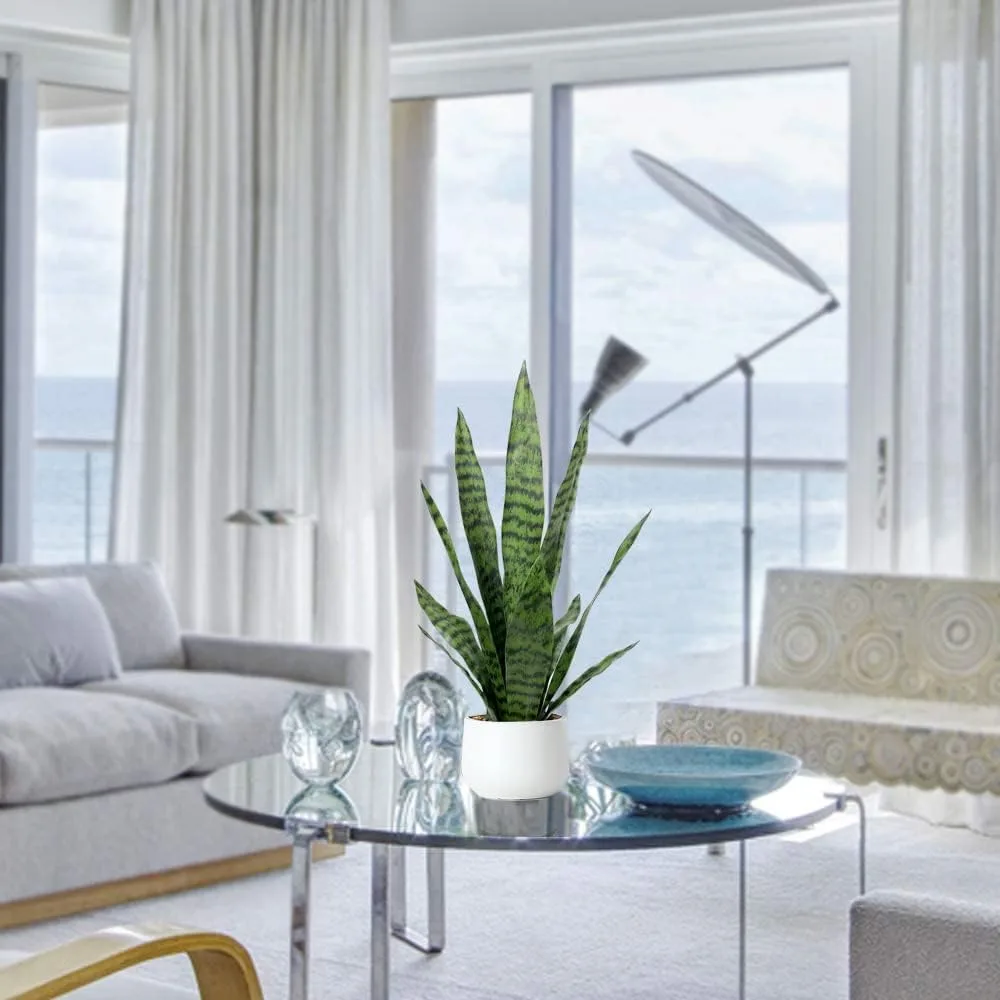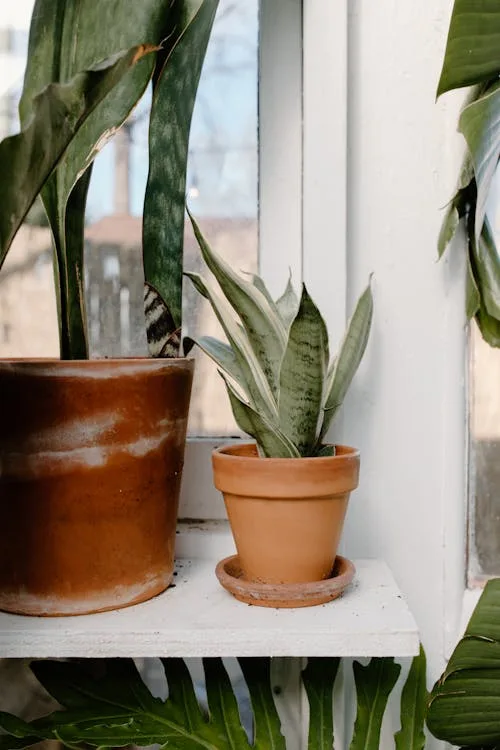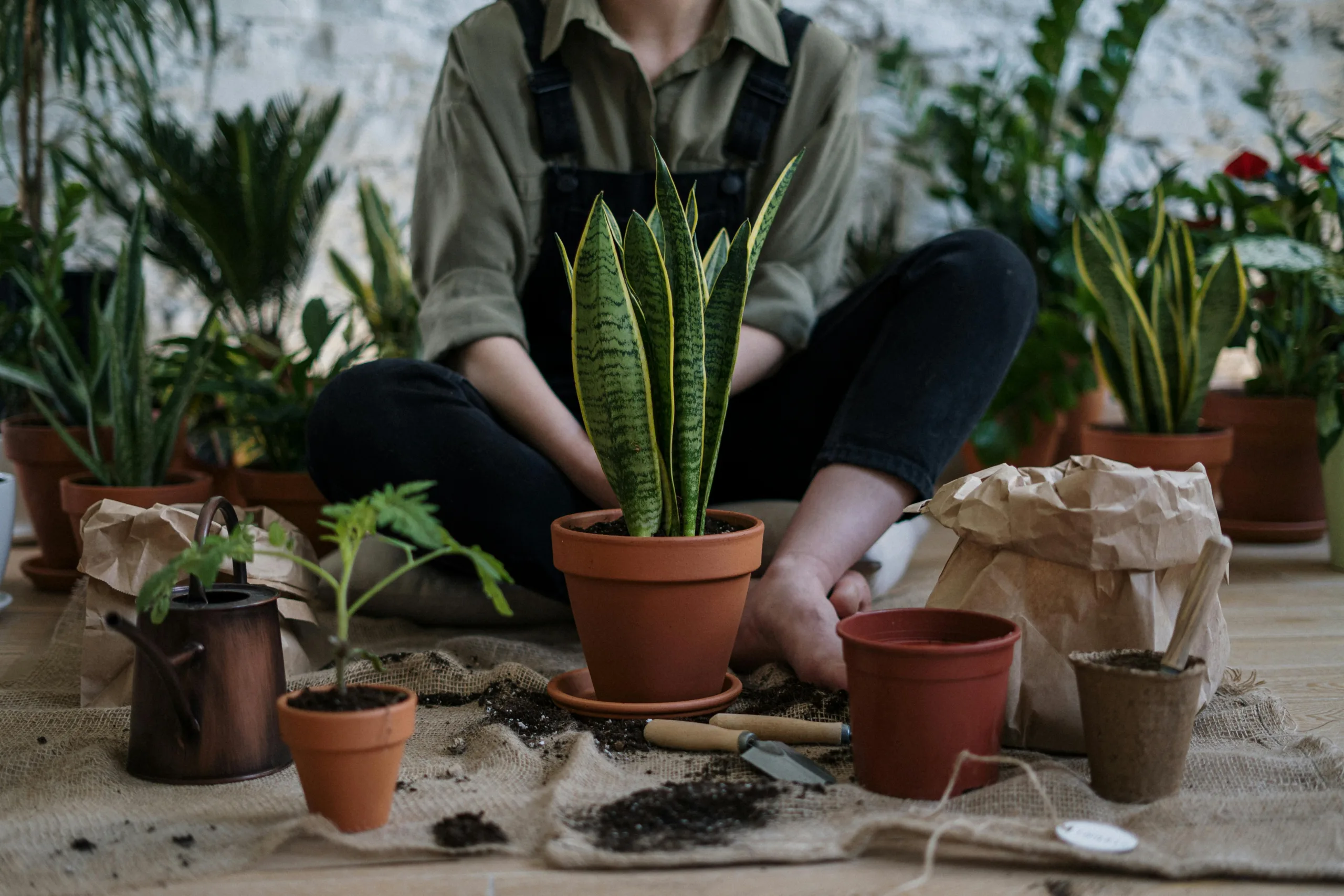The snake plant—also known as Sansevieria or mother-in-law’s tongue—is a favorite in modern interior design for good reason. With its upright, architectural leaves and striking green tones, it brings bold style with minimal effort. Whether you’re outfitting a city loft or a cozy studio, a well-placed snake plant can elevate the mood of your space instantly.
Originally native to West Africa, this plant earned its popularity thanks to its resilience and sleek form. Over the years, it has transitioned from windowsills and waiting rooms into the heart of trend-forward home décor, especially among minimalists and urban dwellers.
But what if you love the look of a snake plant without the watering schedule, pests, or maintenance? That’s where artificial snake plants step in as the ideal solution. High-quality faux options look incredibly lifelike, last for years, and never need sunlight. They offer all the beauty and none of the stress.
In this guide, we’ll explore how you can use an artificial snake plant to enhance your home, recommend our favorite picks, and show you how to style them like a pro. From cozy corners to entryway statements, these sculptural stunners work just about anywhere.
Let’s dive into the world of snake plants and discover why they’ve become a go-to for effortless, evergreen décor.
Table of Contents
Real vs. Artificial Snake Plants: Which One’s Right for You?
If you’ve fallen in love with the clean lines and modern energy of the snake plant, the next question is simple: should you go real or artificial? Both have their place, but understanding the pros and cons will help you make the best choice for your space and lifestyle.
Benefits of Real Snake Plants
There’s no denying that real snake plants are air-purifying wonders. According to studies by NASA and others, they absorb toxins like formaldehyde and produce oxygen—even at night. They’re drought-tolerant, hardy, and thrive with little care. But despite these perks, real snake plants aren’t entirely foolproof.
If placed in low light for too long or overwatered, real Sansevieria can wilt, yellow, or attract pests. And let’s not forget—while beautiful, they’re toxic to pets if chewed, which can be a dealbreaker for many homeowners.
Why Artificial Snake Plants Are Trending
This is where artificial snake plants shine. Today’s faux varieties are more realistic than ever, replicating the plant’s trademark vertical leaves and green variegation with impressive detail. The best part? They require zero upkeep and are completely safe for homes with curious pets or children.
They’re also ideal for rooms with no natural light, travel-heavy schedules, or spaces like rental units and office buildings where long-term plant care isn’t practical. A well-made artificial plant looks stunning in a hallway, bathroom, or entryway—anywhere that needs visual impact with no commitment.
Bottom Line
If you enjoy the rhythm of plant care and have the right lighting, a real snake plant may suit you. But if you value simplicity, allergy-free styling, and design flexibility, investing in a top-quality artificial snake plant is a smart, stylish move.

Top 5 Artificial Snake Plants to Buy Right Now
Ready to bring the sculptural beauty of a snake plant into your home—without worrying about water, light, or toxicity? These five handpicked artificial snake plants are perfect for anyone looking to upgrade their interior with hassle-free greenery that looks remarkably real.
1. Beebel Artificial Sansevieria Greenery Decoration
This lifelike faux snake plant from Beebel features tall, variegated leaves with realistic texture. Set in a minimalist pot, it complements modern, boho, or urban interiors with ease. Its durable construction makes it suitable for both home and office settings.

2. Nearly Natural 4855 Sansevieria with Planter
With a weighted base and rich green hues, this artificial snake plant by Nearly Natural is ideal for corner styling or statement entries. The pot has a neutral tone that blends into most décor schemes, from contemporary to transitional.

3. Artificial Sansevieria Potted Plants for Outdoor
This durable faux snake plant is built for outdoor or indoor use, with UV-resistant leaves that stay vibrant. Its compact size makes it perfect for balconies, patios, or windowsills that need a pop of green.

4. Artificial Sansevieria Ceramic Decoration
Ideal for shelves, desks, or small entry tables, this ceramic-based artificial snake plant brings modern elegance to tight spaces. It’s a simple upgrade with strong decorative impact.

5. Hollyone Artificial Sansevieria Trifasciata
This tall, narrow faux snake plant is perfect for slim spaces where verticality is key. The detail in the leaves and the dark pot give it a premium feel that fits effortlessly into any corner or entryway.

Styling Tips for Snake Plants in Every Room
One of the greatest advantages of the snake plant is its sculptural shape and vertical growth—making it one of the most versatile decorative elements in home design. Whether you’re working with a studio apartment or a spacious open floor plan, here’s how to make this plant work its magic in any space.
Living Room: Statement Corners
Place a tall artificial snake plant in an empty corner next to your sofa or accent chair. Choose a model with a bold ceramic or matte black pot to contrast with neutral furnishings. The upright structure adds movement to rooms with mostly horizontal furniture and makes small spaces feel taller.
Bedroom: Soothing Symmetry
Looking to add greenery to your sleep space? Place matching snake plants on each side of your bed for balance and calm. Artificial versions are perfect here because there’s no risk of attracting pests or overwatering in your sanctuary.
Home Office: Minimalist Energy
A medium-sized snake plant on your bookshelf or filing cabinet creates a sense of order and brings a refreshing visual break to your workday. Faux versions are especially helpful in low-light or windowless offices—keeping things green without effort.
Bathroom: Spa-Like Touches
The sleek shape of a snake plant mimics the feel of a spa when placed near your tub or vanity. Opt for a smaller ceramic planter that complements tile or marble. And since artificial options thrive in humid, dark bathrooms (unlike real plants), they’re a no-brainer.
Entryway: Effortless First Impressions
Welcome guests with a bold snake plant right by your front door. Choose a tall variety to anchor your entry space, and pair it with a mirror or wall art for an elevated design moment. A no-maintenance faux plant keeps things tidy and polished year-round.
Styling Tip:
Snake plants pair well with wicker baskets, modern planters, and pedestal stands. Varying the height and container material is a clever way to make artificial greenery feel curated and personal—not mass-produced.

Snake Plant Care – Real vs. Faux
If you’re on the fence about going faux, it helps to compare what it actually takes to maintain a real snake plant versus choosing a high-quality artificial one. Spoiler: faux might be the better option for busy, style-conscious households.
Real Snake Plants: Low Maintenance, But Not No Maintenance
Real snake plants are known for being hardy. They thrive in low light, tolerate infrequent watering, and purify indoor air. But they’re not 100% foolproof. Overwatering is a common issue, especially in low-light homes, leading to root rot. You’ll also need to dust their broad leaves regularly and rotate them for even growth.
Faux Snake Plants: Zero Maintenance, Full Impact
Artificial snake plants deliver the same bold, upright aesthetic—minus all the maintenance. No watering, no light requirements, and no risk of pests or pet toxicity. With today’s ultra-realistic textures and materials, many faux options look just as good as the real deal.
For example, the Artificial Sansevieria Potted Plant we highlighted earlier looks authentic even up close—and requires nothing more than occasional dusting to stay pristine.
So, Which Should You Choose?
- Choose Real if you enjoy plant care, want natural air purification, and don’t have pets or kids at risk.
- Go Faux if you want zero hassle, live in low-light conditions, or have a tight schedule (or a curious cat!).
Ultimately, both versions of the snake plant have their strengths. But in terms of effort-to-impact ratio, artificial plants are winning more fans than ever.

Where to Place Snake Plants for Best Effect
Whether you’re going for a sleek urban look or aiming to soften a rustic interior, placement matters when it comes to getting the most visual and atmospheric value out of your snake plant. This section breaks down the best zones in your home for maximum style and function.
Near Entryways and Hallways
Placing a tall snake plant in your entry area creates a polished first impression. It anchors the space and adds structure without overwhelming smaller foyers. Look for sculptural varieties like the Nearly Natural Sansevieria in Planter to give your entrance an architectural lift.
Beside Furniture or Corners
Got a dead zone next to your media console or dresser? A vertical snake plant adds life and energy without taking up visual or physical clutter. These plants work especially well with mid-century modern or Scandinavian decor.
Bathrooms and Guest Areas
Snake plants are ideal for compact or awkward spaces like powder rooms and guest bathrooms. Faux options are particularly effective here since there’s no natural light or ventilation needed. A piece like the Ceramic Potted Sansevieria fits neatly into smaller floor space while maintaining visual impact.
Layering with Other Plants
Don’t hesitate to mix your snake plant with other greenery. Use it as a vertical anchor in a trio of planters, flanked by trailing vines or leafy ferns. This works well on console tables, window ledges, or even patios if you’re creating an outdoor look inside.
Wherever you place your artificial plant, let it breathe visually. Surround it with neutral tones or textured surfaces to highlight its dramatic upright structure and elevate the decor of any room with minimal effort.

The Design Appeal of Vertical Greenery
In interior design, vertical lines are known to elongate spaces, add balance, and direct the eye upward—creating a sense of openness and order. This is one reason why vertical greenery has become a staple in modern home styling. Tall, linear plants offer a sculptural element that grounds the room while introducing a natural touch without clutter.
Unlike bushy or sprawling foliage, upright greenery tends to fit well in minimalist environments where every piece must serve a visual purpose. It introduces rhythm and repetition—especially when paired in groups or aligned with furniture lines.
For narrow rooms, entryways, or areas with high ceilings, vertical foliage acts as a visual bridge, connecting the floor to the architecture. It balances out low-profile furniture and adds a sense of proportion to open-concept layouts. Even in eclectic or layered styles, a sleek, upright plant form brings structure to the overall design.
One of the biggest advantages of this type of greenery is its ability to be impactful even in limited square footage. By pulling the eye upward, it makes rooms feel taller and lighter. Whether placed in a corner, beside a sofa, or flanking a fireplace, vertical plants offer elegance and intention without needing elaborate arrangements.
Home decorators often choose these pieces as “visual bookends” in living spaces, using one on each side of a bookshelf or TV console. They’re also ideal for breaking up long stretches of wall without committing to artwork or heavy furniture.
In short, vertical greenery isn’t just a plant choice—it’s a design tool. Its architectural lines and sleek form give you control over your space’s flow and feel. Whether you’re working with neutrals, vibrant color schemes, or earthy textures, a tall, narrow silhouette will always hold its own.
Matching Plants with Decor Styles
Choosing the right artificial greenery isn’t just about what looks real—it’s also about what fits your interior design vision. Each decor style calls for a specific texture, shape, and presentation. Understanding how to pair faux plants with your chosen aesthetic can elevate a space from ordinary to intentional.

Minimalist & Scandinavian
Neutral palettes, clean lines, and functional design dominate both of these styles. Here, subtle, upright greenery works best. Look for structured, narrow plants in white or matte containers to maintain the calm, uncluttered look. Symmetry is key—pair identical plants at opposite ends of a room to reinforce balance.
Boho & Eclectic
These styles thrive on layers, textures, and unexpected combinations. You can go wild with plant variety here: mix tall vertical pieces with trailing vines or cluster assorted small potted greens on shelves and floor baskets. Terracotta and woven planters enhance the earthy feel, while leafier forms add vibrancy.
Modern & Urban
Sleek furnishings, industrial finishes, and bold contrasts define this approach. Statement greenery in metallic or black planters adds visual tension. Use tall artificial plants to introduce natural contrast to high-gloss or concrete surfaces. Sparse, architectural foliage pairs well with exposed materials like steel and glass.
Traditional & Transitional
More formal interiors benefit from symmetrical arrangements and structured greenery. Think of pairing two faux trees on either side of a fireplace or front door. For tabletops, opt for smaller florals in classic urns or footed ceramic vessels. Aim for proportion over drama—greenery should complement, not compete.
Coastal & Farmhouse
Soft, breezy, and inviting—these styles love natural textures and relaxed silhouettes. Artificial greenery with muted greens or frosted tones works beautifully. Pair with driftwood trays, rattan stands, or galvanized containers to echo the relaxed, beachy or rustic aesthetic. Trailing greens or soft, upright stems both work well depending on placement.
Ultimately, the most effective way to use artificial greenery is to treat it as an integral part of your design narrative. Choose pieces that echo your style, and they’ll do more than just fill space—they’ll define it.
Why Faux Greenery Is Trending in Interior Design
Over the past decade, the way we think about indoor plants has changed significantly. Once seen as a luxury tied to green thumbs and abundant sunlight, greenery is now considered a foundational design element—regardless of whether it’s real or faux. And that’s exactly why artificial greenery is surging in popularity.
The Rise of Low-Maintenance Living
Today’s fast-paced lifestyles often leave little time for plant care. Artificial greenery offers a maintenance-free way to enjoy the calming and refreshing feel of nature indoors. No watering, no pruning, and no worrying about sunlight. It’s ideal for busy professionals, families, or anyone who loves the look but not the labor.
Improved Realism and Quality
The days of waxy, plastic-looking plants are over. Thanks to new materials and production techniques, today’s faux options are impressively lifelike—complete with textured leaves, realistic coloration, and even natural imperfections. Many are indistinguishable from their living counterparts until touched.
Better for Pets and Allergies
For households with pets or allergy sufferers, faux greenery provides peace of mind. There’s no risk of toxic ingestion or pollen sensitivity, making it a safe choice for cat and dog owners. If you’re aiming for a pet-safe interior, artificial plants solve several problems in one elegant solution.
Design Flexibility
Unlike live plants, faux ones aren’t restricted by lighting or humidity. You can place them anywhere—from dark hallways to windowless bathrooms—and they’ll still look perfect. This flexibility makes them especially popular among renters and urban dwellers where natural light may be limited.
Cost-Efficiency Over Time
While high-quality faux greenery can be an investment up front, it pays off long-term. There’s no need to replace wilted plants, buy fertilizers, or worry about seasonal changes. Once placed, it retains its look indefinitely with only minimal cleaning now and then.
In short, artificial greenery—whether it’s a potted tree, a structured floral, or a lifelike leaf arrangement—has found its place in modern interior design. It blends aesthetics with practicality, bringing beauty into the home with none of the drawbacks of traditional houseplants.

Frequently Asked Questions
Are snake plants safe for pets?
No, live snake plants are considered toxic to both cats and dogs if ingested. However, artificial snake plant decor is a safe alternative that delivers the same visual appeal without any risk to pets.
How tall do artificial snake plants typically come?
Artificial snake plants are available in a wide range of sizes—from compact 1-foot minis to tall 4–5 foot floor models. This makes them ideal for desktops, corners, or entryways depending on the size and style of your space.
How do I clean a faux snake plant?
Use a microfiber cloth or soft-bristle brush to remove dust from the leaves. For deeper cleaning, gently wipe with a damp cloth and mild soap solution. Avoid harsh chemicals to preserve the finish.
Where is the best place to display a snake plant at home?
These upright plants shine in corners, beside furniture, or flanking doorways. Their vertical structure makes them perfect for spaces with clean lines, such as modern, minimalist, or Scandinavian interiors.
What makes artificial snake plants a better choice than real ones?
Faux snake plants don’t require light, water, or care, and they never shed or attract pests. They offer long-term aesthetic value with zero maintenance and are ideal for anyone looking for a hassle-free greenery solution.
Conclusion
- Artificial snake plants offer a timeless look that fits seamlessly into modern, minimalist, boho, and transitional interiors.
- They are perfect for those who want greenery without the maintenance, mess, or risk to pets and children.
- From compact tabletop versions to tall statement pieces, there’s a faux snake plant for every space and style.
- Each of the curated products in this post brings unique benefits—realistic texture, durable materials, and versatile sizing.
- With no sunlight or watering required, they’re ideal for any corner of the home, especially low-light or high-traffic areas.
- Explore the possibilities of adding effortless, low-maintenance greenery to your space with one of these stunning artificial snake plants.
Whether you’re decorating a home office, freshening up a living room, or simply seeking a stress-free design solution, an artificial snake plant might just be your next favorite decor element.
Want to find out more about artificial plants? Make sure to check out more of our articles here.





Leave a Reply
You must be logged in to post a comment.